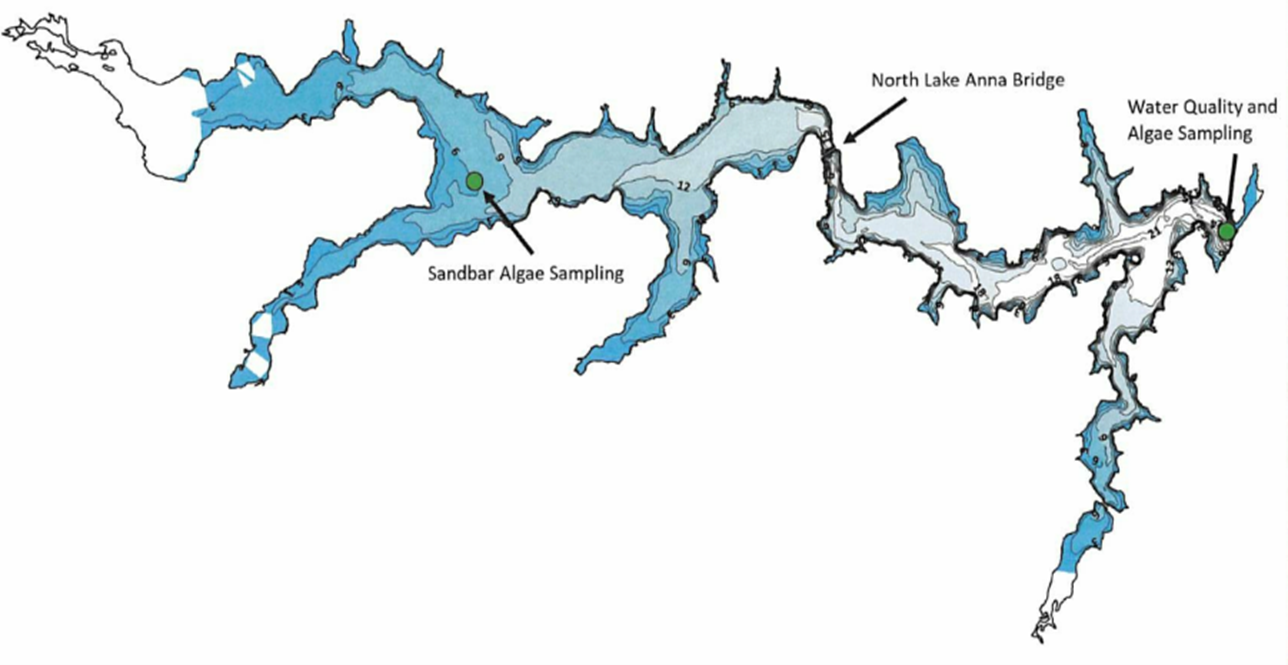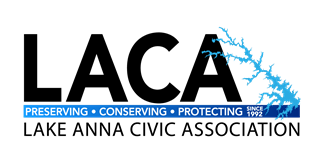Harry Looney – July 2022
The Lake Anna Advisory Committee (LAAC) recently completed an assessment titled “Algal Bloom Assessment and Recommendations for Part of Lake Anna”. LAAC issued a contract to SOLitude Lake Management for the research, data capture and analysis, assessment and recommendations. Field work was conducted between May 2021 and September 2021 consisting of sediment and water sampling and analysis. The final report from the work was published in February 2022 and is available at this link.
This article provides an executive summary of the final report and final briefing conducted by SOLitude Lake Management to the LAAC staff on 23 February 2022.
The primary model used by SOLitude Lake Management for the assessment was the Lake Loading Response Model (LLRM). SOLitude referenced several models that are used within the research community for assessing lakes and other surface waters and documented their reasoning behind the use of the LLRM for this assessment.
The assessment focused on an 865-acre area of Lake Anna in the upper North Anna River branch (see Figure 1). The assessment area starts at the Holladay Bridge and extends NW to where the North Anna River flows into the lake and includes Goldmine Creek, Duckinhole Creek, and Christopher Run. The assessment area comprises less than 10% of the Lake Anna water surface and approximately 40% of the Lake Anna watershed drainage area.

Figure 1: Assessment Area – 865 Acres of the North Anna River
The assessment broke the 865-acre area into 2 separate “basins” based on watershed area, water depth and choke points (see Figure 2).

Figure 2: North Anna River Basins
Basin 1 is fed by a watershed covering 113 square miles and basin 2 is fed by a watershed covering only 33 square miles. Basin 1 is shallow with a mean depth of less than 3 meters while basin 2 is deeper with a mean depth greater than 3 meters.
SOLitude’s data showed that Basin 1 was well-mixed throughout the year and had sufficient oxygen throughout 2021. SOLitude’s data for basin 2 indicated that the lake was stratified and lacked oxygen over the sediments throughout the 2021 algae growing season.
One of the primary research focus areas in the SOLitude assessment was the availability of nutrients, primarily phosphorous, in the water column (dissolved phosphorous) and in sediment.
A key finding in the assessment is that 80% of the phosphorous loading in basin 1 is driven by external sources in the watershed while only 20% of the phosphorous available to the aquatic biomass comes from internal loading (phosphorous stored in sediment).
The assessment found that basin 2 is also driven by external loading (60-70%) in the watershed. SOLitude stated during the final briefing that Lake Anna is a “Phosphorus Limited Lake”, meaning that small increases in phosphorous lead to large increases in algal biomass densities.
The SOLitude final briefing stated that watershed management alone is rarely sufficient to recover lakes impacted by algal blooms. They also stated that data from other lakes and areas with algal issues shows that the contributions from agriculture, forested areas, and septic systems are at least as great as urban and development impacts on a watershed. A general rule of thumb used by environmental engineers is that one square mile of watershed management in developed areas costs $5 million to achieve a 20% reduction in nutrients. The SOLitude analysis shows that 32% of the assessment area watershed is developed. This means that the funding required to manage just the North Anna tributary and watershed could be greater than 220 million dollars.
The final report provides recommendations on different approaches to reduce phosphorous loading and for mitigating algal blooms. The type of approach LACA is currently taking in our Cyanobacteria Mitigation Program (CMP), hydrogen-peroxide-based algaecides, is mentioned in the report on page 62. The final report states that “algaecides provide a low cost and short-term solution to address harmful algal blooms”. The report goes on to state that “peroxide-based algaecides tend to be more selective for many cyanobacteria and leave no potentially harmful residue behind”.  You can find more information on the LACA CMP and our Kick the HAB campaign at this link or by scanning the QR code in this newsletter.
You can find more information on the LACA CMP and our Kick the HAB campaign at this link or by scanning the QR code in this newsletter.
LACA’s decision to focus on near-term mitigation approaches was developed over several years of research and data analysis. The SOLitude report on spot algaecide treatments provides additional justification for LACA’s focus on mitigation efforts that can be implemented now with funding levels that LACA can reasonably raise through donations and grants.
Based on the results of the LAAC assessment, major federal, state, and local funding is needed to get long-term results from watershed management. LACA is working to bring federal, state, and local funding to this problem. Given the large dollar amounts that are needed, a focused, multi-state agency approach is required. That is why the FY23 Virginia State Budget included 1 million dollars of funding for a study on how to mitigate algal bloom issues on Lake Anna. This is a complex problem and the approaches to remedy the problem are numerous, varied, expensive, and primarily long-term before effects are realized. LACA understands that people are tired of studies and data collection but the state funding of 1 million dollars for a study on how to best mitigate the algal bloom issues on Lake Anna is a wise investment to ensure future expenditures are focused on the mitigation and prevention approaches that have the highest probability of success for Lake Anna.
Interested LACA members are welcome to volunteer in support of LACA’s Water Quality Monitoring and Cyanobacteria Mitigation Programs. Contact the Water Quality Project Officer at this link if you are interested in learning more or volunteering.
harry.looney@lakeannavirginia.org
